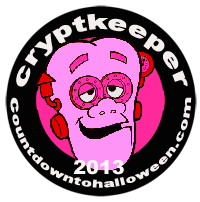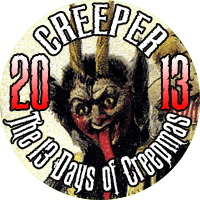Elsa Lanchester
 As the Bride of Frankenstein, her image is arguably the most iconic of any female character in horror history. So why would I list her among horror’s unsung heroines? Before I typed it, how many of you knew the actresses name? That’s what I thought. How many of you can name another movie she was in? Exactly. Elsa Lanchester deserves a spot right next to Bela Lugosi, Boris Karloff, Lon Chaney, Claude Raines, and the rest of the great Universal horror actors. Everyone go check out The Spiral Staircase, Terror in the Wax Museum, or even Mary Poppins and enjoy more of this underrated actress.
As the Bride of Frankenstein, her image is arguably the most iconic of any female character in horror history. So why would I list her among horror’s unsung heroines? Before I typed it, how many of you knew the actresses name? That’s what I thought. How many of you can name another movie she was in? Exactly. Elsa Lanchester deserves a spot right next to Bela Lugosi, Boris Karloff, Lon Chaney, Claude Raines, and the rest of the great Universal horror actors. Everyone go check out The Spiral Staircase, Terror in the Wax Museum, or even Mary Poppins and enjoy more of this underrated actress.
Melinda Clarke
 While she is best known for her non horror TV work on series like Days of Our Lives, The OC, and CSI, and she has only made a 2 horror films (I don’t count Spawn as horror), she belongs on this list for portraying one of my favorite female horror characters of all time. In Return of the Living Dead 3, she does something that has rarely ever been done, infuses a zombie character with extreme emotional gravitas. She plays Julie, whose boyfriend reanimates her shortly after a fatal motorcycle accident. I could have told him that redheads named Julie are trouble. Sorry, couldn't resist. Anyway, she struggles with her new-found hunger, trying hard to fight her transformation for the sake of love. She progressively mutilates herself, as the pain eases the hunger. It is an incredibly complex performance in what is essentially an undead Romeo and Juliet. She is beautiful and grotesque. That movie, and that character in particular, has endured as a favorite of mine over the years. And no, it’s not just because she’s ungodly amounts of hot. How shallow do you people think I am? Never mind, don’t answer that. She can currently be seen on the series The Vampire Diaries, but I hope and pray she returns to the world of horror flicks again.
While she is best known for her non horror TV work on series like Days of Our Lives, The OC, and CSI, and she has only made a 2 horror films (I don’t count Spawn as horror), she belongs on this list for portraying one of my favorite female horror characters of all time. In Return of the Living Dead 3, she does something that has rarely ever been done, infuses a zombie character with extreme emotional gravitas. She plays Julie, whose boyfriend reanimates her shortly after a fatal motorcycle accident. I could have told him that redheads named Julie are trouble. Sorry, couldn't resist. Anyway, she struggles with her new-found hunger, trying hard to fight her transformation for the sake of love. She progressively mutilates herself, as the pain eases the hunger. It is an incredibly complex performance in what is essentially an undead Romeo and Juliet. She is beautiful and grotesque. That movie, and that character in particular, has endured as a favorite of mine over the years. And no, it’s not just because she’s ungodly amounts of hot. How shallow do you people think I am? Never mind, don’t answer that. She can currently be seen on the series The Vampire Diaries, but I hope and pray she returns to the world of horror flicks again.
Debbie Rochon
 If anyone can lay claim to the title of “the hardest working woman in horror” it’s Debbie Rochon. Her IMDB credits her with 193 movie appearances, almost all of them horror. She is one of those actresses that are well known in the independent horror community, but under the casual and mainstream fan’s radar. Lloyd Kaufmann, head of Troma studios, called her “The Goddess of Independent Cinema.” She tirelessly works in indie and low budget horror, being one of the scene’s most prominent and vocal supporters. She is extremely talented, and is just as effective playing a psychotic murderer as she is getting killed. While many view the world if independent cinema as a stepping stone, she has stated on many occasions that while she would do major studio flicks, she loves the artistic freedom allowed outside of the Hollywood system. Some of her best known films include Tromeo and Juliet, Abducted 2: The Reunion, Dead and Rotting, Cremains, American Nightmare, Santa Claws, and my personal favorite, Hellblock 13.
If anyone can lay claim to the title of “the hardest working woman in horror” it’s Debbie Rochon. Her IMDB credits her with 193 movie appearances, almost all of them horror. She is one of those actresses that are well known in the independent horror community, but under the casual and mainstream fan’s radar. Lloyd Kaufmann, head of Troma studios, called her “The Goddess of Independent Cinema.” She tirelessly works in indie and low budget horror, being one of the scene’s most prominent and vocal supporters. She is extremely talented, and is just as effective playing a psychotic murderer as she is getting killed. While many view the world if independent cinema as a stepping stone, she has stated on many occasions that while she would do major studio flicks, she loves the artistic freedom allowed outside of the Hollywood system. Some of her best known films include Tromeo and Juliet, Abducted 2: The Reunion, Dead and Rotting, Cremains, American Nightmare, Santa Claws, and my personal favorite, Hellblock 13.
Dyanne Thorne
 She has appeared in a few horror films, such as Point of Terror, Blood Sabbath, and Hellhole, but Dyanne Thorne will always be best remembered as Ilsa, She Wolf of the SS. As the brutal Nazi commandant, she embodies the duality of seductive and evil. Thorne is completely believable as she presides over the torture and sexual degredation carried out under her orders. She can exude a palpable sense of malice and insert her absolute authority simply with a look. In all 4 Ilsa movies, she typifies the term femme fatale. As Joe Bob Briggs once said, “She’s the kind of woman that might make love to you, or she might kill you, and you really don’t care which.”
She has appeared in a few horror films, such as Point of Terror, Blood Sabbath, and Hellhole, but Dyanne Thorne will always be best remembered as Ilsa, She Wolf of the SS. As the brutal Nazi commandant, she embodies the duality of seductive and evil. Thorne is completely believable as she presides over the torture and sexual degredation carried out under her orders. She can exude a palpable sense of malice and insert her absolute authority simply with a look. In all 4 Ilsa movies, she typifies the term femme fatale. As Joe Bob Briggs once said, “She’s the kind of woman that might make love to you, or she might kill you, and you really don’t care which.”
Tiffany Shepis
 Tiffany Shepis is a strong candidate to be the successor to Debbie Rochon’s modern scream queen throne. Since her debut in Tromeo and Juliet (ironically also starring Rochon) she has made over 60 independent horror movies, as well as many comedies, music videos, and “erotic thrillers.” Citing Brinke Stevens and Mindy Clarke as influences, she said in an interview “I have never wanted to win an Oscar, my only goal for my career is to make one bad ass horror film that reaches a more mainstream audience.” If that statement alone doesn’t earn her a spot on this list, I don’t know what would. Check her out in Death Factory, Bloody Murder 2, Delta Delta Die, Chainsaw Cheerleaders, Zombies Zombies Zombies!, and the Night of the Demons remake.
Tiffany Shepis is a strong candidate to be the successor to Debbie Rochon’s modern scream queen throne. Since her debut in Tromeo and Juliet (ironically also starring Rochon) she has made over 60 independent horror movies, as well as many comedies, music videos, and “erotic thrillers.” Citing Brinke Stevens and Mindy Clarke as influences, she said in an interview “I have never wanted to win an Oscar, my only goal for my career is to make one bad ass horror film that reaches a more mainstream audience.” If that statement alone doesn’t earn her a spot on this list, I don’t know what would. Check her out in Death Factory, Bloody Murder 2, Delta Delta Die, Chainsaw Cheerleaders, Zombies Zombies Zombies!, and the Night of the Demons remake.
Soledad Miranda
 Soledad’s story is a tragic one. The Spainish actress appeared in a comedy directed by future Euro-horror auteur Jess Franco the age of 16. Four years later she made her horror debut, earning great reviews for her performance in Pyro…The Thing Without a Face. She then made Sound of Horror with another great Scream Queen, the debuting Ingrid Pitt. After getting married and having a son she only did TV work for the next four years, until she reunited with Franco for a trio of horror masterpieces, Count Dracula (costarring with Christopher Lee) Vampyros Lesbos and She Killed in Ecstasy. These films were well received, and she was poised to become the darling of the European horror industry. She had already signed on for 6 more horror flicks when she died in an automobile crash in 1970. She is generally considered to be Franco’s greatest discovery (which is saying something), and there’s no telling how far her beauty and talent could have taken her.
Soledad’s story is a tragic one. The Spainish actress appeared in a comedy directed by future Euro-horror auteur Jess Franco the age of 16. Four years later she made her horror debut, earning great reviews for her performance in Pyro…The Thing Without a Face. She then made Sound of Horror with another great Scream Queen, the debuting Ingrid Pitt. After getting married and having a son she only did TV work for the next four years, until she reunited with Franco for a trio of horror masterpieces, Count Dracula (costarring with Christopher Lee) Vampyros Lesbos and She Killed in Ecstasy. These films were well received, and she was poised to become the darling of the European horror industry. She had already signed on for 6 more horror flicks when she died in an automobile crash in 1970. She is generally considered to be Franco’s greatest discovery (which is saying something), and there’s no telling how far her beauty and talent could have taken her.
Debi Sue Voorhees
 This entry may get groans from the more feminist minded readers, but I’m just being honest. I was a young teen, aka throbbing ball of hormones, when I started watching horror movies. One of my favorite ingredients in these films, especially the 80’s slashers, was indeed the gratuitous nudity. My favorite, um…scene, was Debi Sue Voorhees’s in Friday the 13th part 5. I was quite taken with the…um…apex of her dramatic range. She only made two other horror movies, Appointment With Fear (terrible) and Innocent Prey (pretty good), before disappearing from the film industry. Her career may have been brief, but for a couple of big reasons she will always have a special place in my heart. Oh, and sorry about the censorship, but this is more or less a family show.
This entry may get groans from the more feminist minded readers, but I’m just being honest. I was a young teen, aka throbbing ball of hormones, when I started watching horror movies. One of my favorite ingredients in these films, especially the 80’s slashers, was indeed the gratuitous nudity. My favorite, um…scene, was Debi Sue Voorhees’s in Friday the 13th part 5. I was quite taken with the…um…apex of her dramatic range. She only made two other horror movies, Appointment With Fear (terrible) and Innocent Prey (pretty good), before disappearing from the film industry. Her career may have been brief, but for a couple of big reasons she will always have a special place in my heart. Oh, and sorry about the censorship, but this is more or less a family show.
Caroline Munro
 Caroline Munro made her horror debut playing the dead wife of Vincent Price in The Abominable Dr. Phibes and Dr. Phibes rises again. She became a Hammer Studios contract actress, appearing in Dracula AD 1972 and Captain Kronos – Vampire Hunter. Later, she came to America and co-starred in the slasher classic Maniac and The Last Horror Film, both with the great Joe Spinell. Throughout the 1980’s she appeared in a wide variety of horror projects, like Don't Open Till Christmas, Slaughter High, Howl of the Devil, Faceless, and Demons 6: The Black Cat. She appeared in Flesh for the Beast and Absence of Light in the 2000’s, and has a musical horror comedy called Eldorado coming out next year. An excellent actress, she became a fan favorite for her sultry presence and a very good scream. She is also notable due to the fact that, unlike most of the actresses on this list, she refused to ever appear nude in a film, turning down many high profile and lucrative roles because they required nudity. Whether or not that is a good thing can be debated, but you gotta respect anyone for sticking to their standards in the face of fame and money.
Caroline Munro made her horror debut playing the dead wife of Vincent Price in The Abominable Dr. Phibes and Dr. Phibes rises again. She became a Hammer Studios contract actress, appearing in Dracula AD 1972 and Captain Kronos – Vampire Hunter. Later, she came to America and co-starred in the slasher classic Maniac and The Last Horror Film, both with the great Joe Spinell. Throughout the 1980’s she appeared in a wide variety of horror projects, like Don't Open Till Christmas, Slaughter High, Howl of the Devil, Faceless, and Demons 6: The Black Cat. She appeared in Flesh for the Beast and Absence of Light in the 2000’s, and has a musical horror comedy called Eldorado coming out next year. An excellent actress, she became a fan favorite for her sultry presence and a very good scream. She is also notable due to the fact that, unlike most of the actresses on this list, she refused to ever appear nude in a film, turning down many high profile and lucrative roles because they required nudity. Whether or not that is a good thing can be debated, but you gotta respect anyone for sticking to their standards in the face of fame and money.
Amelia Kinkade
 The Night of the Demons trilogy are some of my favorite horror movies ever, and the anchor of the series is Amelia (sometimes credited as Mimi) Kinkade’s performance as Angela. She throws herself into the role of the possessed goth chick with an over the top abandon and gleefull cheesiness. Later in the series, she is a bit more subdued and subtle, but still possesses an incredible demonic energy. Mimi, who holds a degree in modern dance, also has two classic dance sequences in the series, one to Stigmata Martyr by Bauhaus and the other to Rapture by Morbid Angel. Yes, she actually dances to Morbid Angel. That alone makes her legendary. The NOTD movies were her only contribution to horror cinema (My Best Friend is a Vampire doesn’t count), but few actresses have truly embodied a single character throughout multiple movies the way Mimi does Angela.
The Night of the Demons trilogy are some of my favorite horror movies ever, and the anchor of the series is Amelia (sometimes credited as Mimi) Kinkade’s performance as Angela. She throws herself into the role of the possessed goth chick with an over the top abandon and gleefull cheesiness. Later in the series, she is a bit more subdued and subtle, but still possesses an incredible demonic energy. Mimi, who holds a degree in modern dance, also has two classic dance sequences in the series, one to Stigmata Martyr by Bauhaus and the other to Rapture by Morbid Angel. Yes, she actually dances to Morbid Angel. That alone makes her legendary. The NOTD movies were her only contribution to horror cinema (My Best Friend is a Vampire doesn’t count), but few actresses have truly embodied a single character throughout multiple movies the way Mimi does Angela.
Bobbi Sue Luther
I put her on this list because I see big things in her future. She has the potential to be a horror star. She’s off to a good start, having a couple of really good movies under her belt already. This model turned actress made a couple of comedies and TV appearances in the early 2000’s, and then made her horror debut in The Poughkeepsie Tapes in 2007. That flick has been repeatedly recommended to me, and I would LOVE to get my hands on a copy (hint hint readers). She appeared in the Robert Englund directed Killer Pad, and then starred in the excellent slasher flick Laid to Rest. Her performance in Laid to Rest was truly impressive. Her next appearance was in the Night of the Demons remake. Only 4 films into her horror career, I believe she very well could be the next big scream queen. Mark my words, we’re going to be seeing a lot more of her.

























